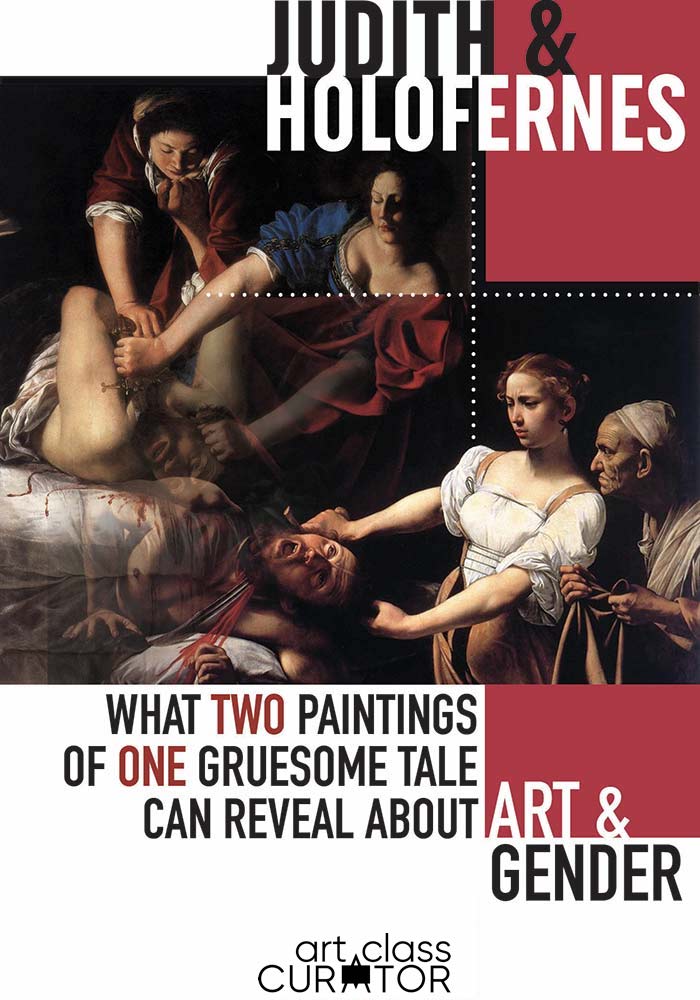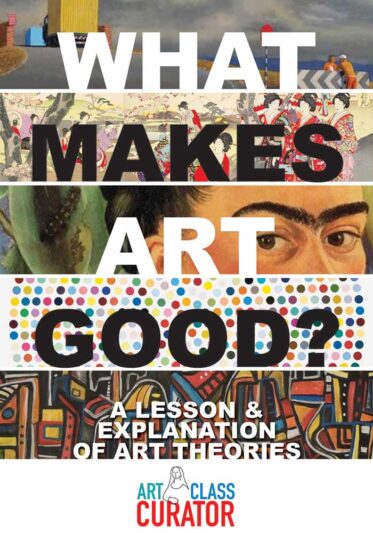Inside: Art lesson ideas and activities for comparing two Baroque Judith and Holofernes paintings. Which was made by a man and which was painted by a woman?

Let’s talk about decapitation for a minute.
Did I draw you in with that hook? Whether you rose your eyebrows or nodded with excitement, you’re curious about what I’m going to say next, and your students will be too.
Throughout art history, there are topics and stories that we see repeated time and again by different artists, because they capture the imagination and ignite our emotions. One example of this is Judith and Holofernes paintings based on the story of Judith slaying Holofernes from the Septuagint and the Catholic and Eastern Orthodox Christian Old Testament of the Bible. This story is represented in more than 114 paintings and sculptures!

Please note, this post includes Amazon affiliate links. As an Amazon Associate I earn from qualifying purchases.
Judith and Holofernes Paintings
To sum up the story, Holofernes, an Assyrian general and our dastardly villain, was tasked by the king to destroy Judith’s hometown, the city of Bethulia. Judith, a beautiful widow, charms and befriends Holofernes and is allowed into Holofernes’ tent because of his desire for her. After he gets drunk and passes out, she chops of his head and carries it away in a basket back to Bethulia to prove to her neighbors that their troubles are over. Bam!
These two representations of the story are remarkably similar, but the differences stand out. One of my all-time favorite art lessons is to have students compare and contrast these two Judith and Holofernes paintings. It’s a great lesson in looking closely. The longer you can keep a student looking and thinking, the more they will get out of it. Have your students notice the similarities and differences between the colors, lighting, postures, and expressions of the people, actions, lines, and emotions. There’s plenty to keep students exploring and engaged.
(Facebook video not working? Watch on YouTube.)
Discussing Gender in Art
I always follow up the compare and contrast activity with a thought-provoking question: “Which of these paintings was painted by a woman, and which was painted by a man?
Think about it. What do you think the correct answer is? How can you tell one was painted by a woman and one a man?
Notice how the women are painted. In the first one, the woman is strong and determined. She’s got her knee on the bed, really going for it. In the second, the woman is delicate and looks disgusted. She’s leaning away from the action, keeping her distance. Her body language is timid and worried.

Free Poster
What Do Kids Learn from Looking at Art Poster
Our students learn so much from looking at art. Use this poster in your classroom to remind them of all the skills they’re growing!
Classroom Art Discussion
I’ve led this discussion with countless groups of students–high-schoolers, college students, and adults. Answers and reasons always vary, and there is always an interesting discussion. Even when they get the answer “wrong,” it is still is an interesting way to explore gender and stereotypes. It’s a great way to encourage deep learning about the lives of artists.
Are you ready for the correct answer? Did you think about it first?
The first is the woman artist — Artemisia Gentileschi). The second is the man — Caravaggio. Did you get it right?
Gentileschi, a rare woman painter from the past, led a tumultuous life. She painted strong and powerful women, as well as women being oppressed or exposed. Although we tend to connect a woman’s life to her painting more than we do with male painters (see this post about the lives of artists), it’s hard to resist seeing the connection here. As a teenager, she was raped by a friend of her father. At the time, the woman was usually seen at the one to blame. There was a trial and she almost married the man who raped her. You can read about her life in the awesome biographical novel, The Passion of Artemisia by Susan Vreeland. I highly recommend this book. I read it years ago and loved it.
See more of Artemisia Gentileschi’s artwork here.
Art Learning Activities for Judith Slaying Holofernes
- Compare and contrast the two works. After noticing all the similarities and differences, ask your students which painting was painted by a man and which a woman. Ask them to explain their answer. Use the compare and contrast art activity from the bundle of free art appreciation worksheets to get students thinking. (See photo below.)
- Study Baroque art to better understand the characteristics of these two works. Use my Baroque lesson that includes this activity along with other compare/contrast activities to teach the main characteristics of Baroque. Buy the lesson here or join the Curated Connections Library to get the lesson materials.
- Read my post about Exploring Narrative in Art for more activities to support and connect with stories in art.
- Check out other representations of the story (below) and talk about which paintings depict the story more effectively and what choices artists makes to tell stories.
- Watch the Khan Academy Smarthistory video about Gentileschi’s version of this story.
- The following worksheets from my $12 Printable Art Appreciation Worksheets Bundle work well with these artworks: 4 Steps of Art Criticism, Compare and Contrast, Twitter Perspectives, Write a Letter, Formal Analysis–Elements of Art, Charlotte Mason Picture Study, Write a Haiku, and the “I am” Character Poem. Many of these worksheets are also available in my free worksheets bundle for e-mail subscribers.
This post was originally published on October 27, 2014.








I have signed up multiple times to receive the emails weekly and have not received anything. Can you check and see if I am properly signed up? I have purchased the printable booklet Art Around the World as well, and signed up when I purchased it.
Thank you,
Barbara Ferreira
Hi! I just checked, and it says you’ve gotten lots and lots of e-mails dating back to January, but you’ve only opened a couple. Chances are you are using a school account, and they are being blocked (school accounts are tricky like that!). You might try joining with your personal e-mail address. Those are more reliable! Or, check your junk/spam filter on your school account.
To what age group do you present this lesson? I love it, but I’m worried about presenting it to even my upper elementary students. Do you have an alternative that poses some of the same questions. I love that you paired pictures of the same topic to address gender issues. Too cool.
Hmm, I’ve done it with both high school and college. I can’t think of an alternative right now. I suppose you could have a similar conversation with other, less graphic works by the two artists. Maybe this one–Martha and Mary Magdalene by Caravaggio (https://en.wikipedia.org/wiki/Martha_and_Mary_Magdalene_%28Caravaggio%29) and Mary Magdalene by Gentileschi (https://en.wikipedia.org/wiki/Artemisia_Gentileschi#/media/File:Artemisia_Gentileschi_Mary_Magdalene_Pitti.jpg). What do you think? The Gentileschi one is much more emotional than the Caravaggio, so it might work?
Love the lesson, but just a quick correction: the book of Judith is not found in mainstream Christian bibles. It can only be found in the Orthodox and Catholic bibles.
Thank you! I’ll add it to my to do list to make the clarification. 🙂 That makes sense. Italian Baroque was uber-Catholic. 🙂
Your commenter above is also wrong. Judith is part of the Old Testament, so originally, a Jewish book. It was removed from the Old Testament by Protestants who were picking and choosing which parts of the Bible fit their agenda (and adding words here and there). They threw out all the Jewish books found only in the Septuagint, and Judith was one of them. So, the original Christian canon, still used by Catholics and Orthodox, includes Judith and several other books in the Old Testament that the Protestants got rid of. A little history there 😉 and particularly interesting when looking at the period during which these were painted.
Love your site, good stuff, thanks!
Thanks!
Thank you for the Holofernes citation. I am an art teacher in Seattle. Last year we had an over the top amazing show of Kehinde Wiley’s work at SAM. The piece that caused the most still with my students was his depictions of the scene. SAM did not do a good job citing its origins. Thank you for giving me better than my old Gardner’s text. And now you know about a contemporary art work to reference.
I think I’ve seen his work here in DFW! Incredible! I’ll look out for the Holofernes one. I’ll have to write a follow up post about his version!
Your site was mention in an Art of Education course I am taking. Thought you might like to know when you are complimented. I hope to use you as a resource in my K-5 curriculum this year as well.
Awesome, thank you!! I didn’t know that. 🙂
Wow I have just come across your site and am blown away! Your lessons are great! I love teaching Carravagio to my High School students…but to mix it in with the Gentileschi..with a gender/ strereotype tangle…and a contemporary link to Kehinde Wiley.
Thankyou!
You’re welcome and thank you! 🙂 Baroque is one of my favorite topics. So much fun stuff you can do. 🙂
This is a great lesson – do you think it would be suitable for 6-8th grade students? I am a new art teacher – 2nd year – at a Christian school.
Yes, I think you could do it!
Just wanted to note that, according to a Wikipedia article, Artemesia was not forced to marry her rapist. (https://en.wikipedia.org/wiki/Artemisia_Gentileschi) There was a trial, and she was subjected to many indignities by the court, but the rapist was actually sentenced to a year’s imprisonment, though he never served time. Artemesia eventually married another artist, Pierantonio Stiattesi. The novel may have been taking dramatic liberties, or perhaps the author has access to some better or more recent scholarship. I think it’s important to try to get history right for our students, though it often seems like moving target with new scholarship sometimes shifting the ground beneath our feet!
Thank you so much! That’s one of those things I have in my head that I probably should double check before I write down. Argh. I bet I read it in the book and got it mixed up with truth! I’ll put in on my to-do list to correct!
I have wanted to do a compare/contrast lesson on Judith slaying Holofernes ever since I saw paintings on the subject in college. I am now 50 and never have created the lesson. I have always taught elementary students and it would not be appropriate for that age group. I’m so glad to see that someone else had the same idea! Even though I can’t use the lesson, it made me happy to see it! Thanks!
Hello Cindy,
This is a very provocative lesson. I recently read “Educated” by Tara Westover, in which she mentions first being exposed to the Caravaggio painting in an art history class and later seeing it in person in Rome. I was looking for more information about the painting and discovered your website.
My reaction to the painting on the right was that it was done by a woman because it captured the rage and desire for revenge that a woman “seduced” (i.e. raped) would express. The other (the Caravaggio) missed the revulsion and anger Judith would have felt.
Thank you for this lesson. Excellent.
You’re welcome and thank you! I haven’t read that yet. I’ll add it to the list!